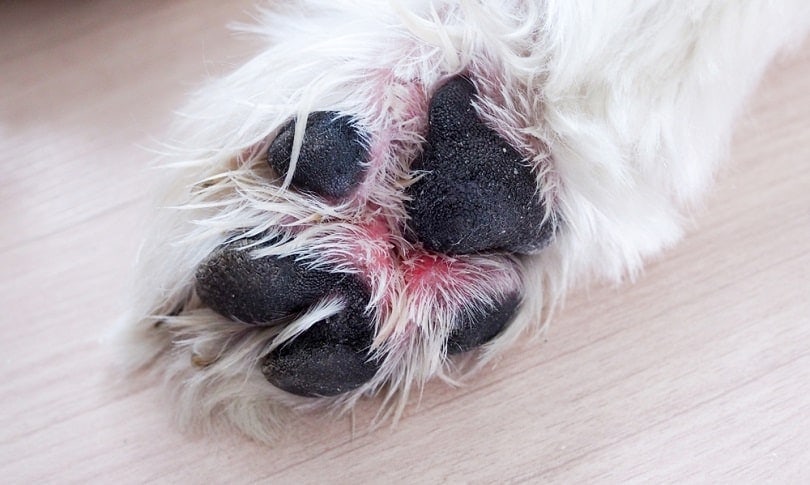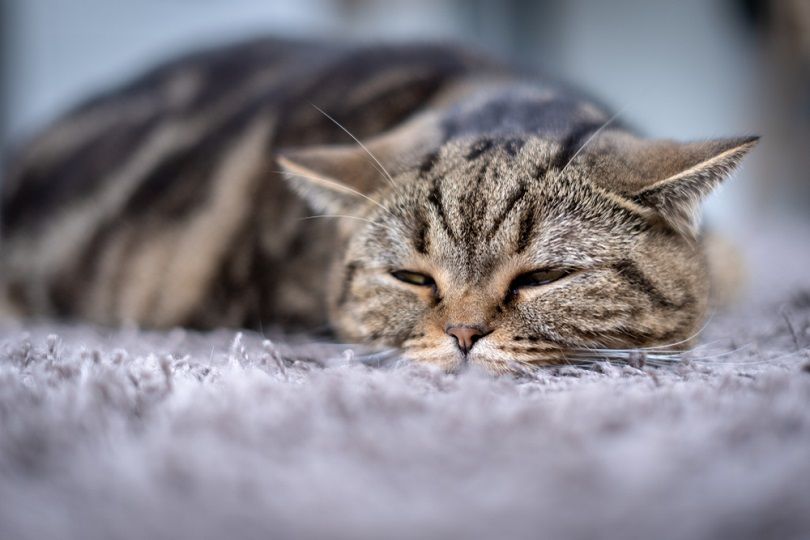Why Is My Dog Losing Hair in Patches and Scabs? (Vet Answer)
By Dr. Sharon Butzke, DVM (Vet)
Updated on

It can be alarming if your dog starts developing bald patches, especially if their skin is also scabby. When these signs occur together, it indicates that the skin is inflamed, and that a skin infection may also be present. You may also notice your dog scratching, licking, or chewing at themself.
Unfortunately, there are many possible causes of hair loss and scabbing in dogs. In most cases, you will not be able to determine the cause by simply examining your dog at home. A visit to your veterinarian is warranted, as treatment will depend on the reason for your pup’s symptoms.
While this list is not exhaustive, the following are some common causes of hair loss with scabs in dogs:
The 6 Reasons Why Your Dog is Losing Hair in Patches and Scabs
1. Flea Allergy Dermatitis (FAD)

Fleas are pesky little insects that can cause severe discomfort! Some dogs have a hypersensitivity reaction to flea bites and can develop flea allergy dermatitis (FAD). Affected dogs often lose hair around the base of their tail initially. Constant scratching, licking, and chewing lead to sores and scabs, which can become infected.
Large numbers of fleas on a dog are usually pretty easy to find, but dogs with FAD may only have a few fleas. Check out this video to learn how to check your pet at home.
- Veterinary flea medications are safe and effective and start killing fleas very quickly (in as little as 30 minutes)
- The presence of scabs can indicate a skin infection that may require antibiotics
- Dogs with FAD may benefit from medication to provide relief from their intense itching
Fortunately, treating fleas is usually straightforward. Remember to treat all pets in your home, but never use dog products on cats, as they can be highly toxic.
2. Mange
Mange is caused by microscopic mites that can cause severe skin irritation. There are two different types of mange in dogs:
Demodectic Mange
Demodex mites live in the hair follicles of almost all dogs, but their immune systems usually control the population so that they do not cause a problem. However, the mites can multiply quickly in young puppies with immature immune systems and immunocompromised adult dogs.
This leads to hair loss, which usually is first noticeable on the face and around the eyes. Demodectic mange is not contagious, and it does not typically make dogs itchy unless the skin becomes secondarily infected with bacteria or yeast.
Sarcoptic Mange (Scabies)
Sarcoptes scabiei mites should not be found on normal dogs’ skin. They are contagious and can spread to people. Dogs with sarcoptic mange develop red, scabby areas of hair loss, typically on parts of the body with little hair. These include the ears, elbows, and hocks. In severe cases, the underside of the chest and belly may also be affected.
A diagnosis of mange can sometimes be made by finding the offending mites on skin scrapings, which are examined under a microscope. However, the absence of mites does not rule out mange. Your veterinarian may recommend treating your dog empirically and watching to see if their signs improve or resolve.
Many common prescription flea and tick medications also treat mange effectively and are generally very safe. Any secondary infections will also need to be addressed.
3. Hot Spots

Some dog owners are unfortunately familiar with the term “hot spot,” used to describe a skin condition called acute moist dermatitis or pyotraumatic dermatitis. Hot spots occur when a dog persistently scratches, licks, or chews at the skin on a particular part of their body. This self-trauma creates a wound, which often becomes infected. Hair loss at the site may be minimal or significant.
Hot spots can have many different causes. Affected dogs are very uncomfortable, and hot spots are usually treated by clipping the remaining fur around the lesion and then cleaning the area thoroughly. This may need to be performed under sedation for the dog’s comfort and safety.
Antibiotics are often required, as well as medication, to provide much-needed itch relief. It is also vital to prevent further damage to the skin. Your dog may need to wear a cone to discourage licking until the hot spot is fully healed.
4. Skin Infections
Skin infections in dogs can be caused by bacteria, yeast, or both simultaneously. Infections are often classified as localized (contained to a small area of skin) or generalized (affecting a large part or most of the body). They are frequently secondary to other skin conditions.
Veterinarians often collect samples from the skin’s surface to examine under the microscope and help determine the cause(s) of the infection. Treatment may involve oral medication, topical preparations (e.g., medicated shampoo, spray, or cream), or a combination of both.
It is crucial that you follow your veterinarian’s directions closely and bring your dog back for any recommended visits to monitor their progress. Let your veterinarian know immediately if your dog is not getting better because bacteria and yeast are sometimes resistant to certain medications.
Many skin infections in dogs are not contagious to other dogs or people, but your veterinarian will let you know if you need to take any special precautions.
5. Allergies

Similarly to people, dogs can have adverse reactions to food and environmental allergens. Signs of allergies in dogs often include itchy skin, which leads to scratching, which can progress to hair loss and scabby lesions.
Food allergies can be challenging to diagnose in dogs, as there is currently no effective testing method for them. An elimination diet trial is often the first step. It is essential to follow your veterinarian’s directions exactly! Be prepared that it may take some time to see improvement in your dog’s signs and to figure out what they are reacting to.
For dogs with suspected environmental allergies, intradermal testing (IDT) is considered the gold standard for diagnosis. However, it can be expensive. This test usually requires a referral to a veterinary dermatologist, and your dog will be given sedation to help them stay still during the procedure.
Unfortunately, there is no cure for allergies, and treatment is lifelong. However, the signs can often be managed, and most dogs can still have a good quality of life.
6. Ringworm (Dermatophytosis)
Ringworm is not caused by a worm but by fungi called dermatophytes. Dogs do not always develop the classic ring-shaped lesions seen in people, but they often lose hair. Red bumps can also form on the skin and lead to scabs. Dogs are not usually itchy unless a secondary infection is present.
Conclusion
If you notice your dog is losing hair and developing scabs, schedule an appointment with your veterinarian. This combination of reactions indicates skin inflammation and often an infection.
Identifying the cause and implementing treatment sooner rather than later will improve your dog’s comfort, and early intervention should prevent the skin condition from worsening. Your pup will thank you for it!
See Also:
- Best Dog Foods for Hair Loss – Reviews & Top Picks
- Alopecia X in Dogs: Causes, Signs & Treatments (Vet Answer)
Featured Image Credit: Marina.Martinez, Shutterstock













